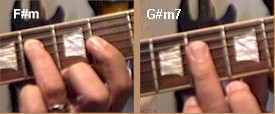Scroll through the lesson and click on notation/video/audio links to load the interactive players.
Please subscribe to get full access to all lessons for only $7.95/month PLUS 1 week free trial.

Riff Interactive lessons are
LESS expensive and
MORE interactive than alternatives!
More Info
|
|

Jam Sessions - Smooth Jazz
Style
Lesson 2 - Jam in F#m
Lyle:
Ready? Here we go! Use a clean sound from your amp along with a touch of reverb.
Also try using the neck pickup for a fatter and warmer tone. Set your amp tone
controls all to medium or about 50% and adjust from there.
Lyle:
Now let's get going on this jam session in F#m. Here's the two chords used:
chords

chord chart

Lyle:
Here's the main rhythm riff using just these two simple chords:
Lyle: In
the main groove of the jam track there are a couple other rhythm guitars playing
little parts. Here's what they are in case you have a couple of you jamming on
this together, you might find it fun to work out these other parts.
Lyle:
Here's another rhythm riff using a higher F#m chord:
Lyle: If
you had three guitar all playing these three parts together you'd end up with
the rhythms on the jam track. All three look like this
Lyle:
Try looping the last TAB file and play along, then switch to one of the other
rhythm riffs, or just use the regular jam track to play along with. The circled
notes just help highlight the riff.
Lyle: Let's move into soloing with the jam track.
You're in F#m so a simple scale to use would be the F# minor pentatonic scale.
Lyle:
One of the key elements to the smooth jazz style for guitar is what I refer to
as the "secret slide". It's just a legato slide effect:
Lyle:
Strike the first note and then slide the same fret-hand finger up or down to the
second note. The second note is not struck.
Lyle:
Now take the basic F# minor pentatonic scale and slide into every note that
comes along to your index finger within the scale pattern like this:
Lyle:
You can practice sliding all the notes like this:
Picky: I like
how that half-step slide really adds that "jazz" sound.
Lyle: It comes in handy as it seems the smooth
jazz style for guitar doesn't bend the strings too much, maybe because they are
a heavier gauge.
jax: Wow, I like that slide into every
note!
Lyle: Try it with other scales too, like the F#
minor blues scale:
Lyle:
These two chords, F#m and G#m7 are the ii and iii chords in the key of E major.
This means the F# Dorian minor scale is the basic minor mode you would want to
use:
Lyle: We
are in F#m, but it's the ii minor of the key of E major.
Lyle:
Try playing the EMaj scale against the jam track and you'll hear how well it
fits.
jax:
That's weird how both Emaj and Amaj scale sound good?
Lyle: A Lydian major would work
better:
Paul: A Lydian
is what scale degree?
Lyle: The
4th.
Paul: Same
as E major then right?
Lyle: A is the 4th of E
Major.
Lyle: The A Lydian shares the same notes as the E
Major.
Lyle: It's like starting on A and ending on A
within the E major scale:
BradB: Good
thing I can slow down the jam track, I can't play the scales fast
enough.
Lyle: Brad, you can
also just play the scales a little slower, with more "feeling" too, instead of
slowing down the jam track. If you're playing the scale notes slow, use vibrato
when holding/sustaining notes.
Lyle: I tabbed out the solo from the lesson
sample. It uses these scales and the sliding riff technique. Here's the first
riff:
Lyle: As
you see, I just started in on showing you a solo I made up for this jam using
the scales I've just shown you. Notice I'm sliding around to help give it the
smooth jazz sound. Practice that riff to the jam track over and over like I did
in the video clip and you'll get it down in no time.
Lyle: In
the next riff I play an Emaj7 arpeggio in the first measure, then an E major
scale descending in the second measure:
Lyle: The next riff is a repeating variation of
the very first riff in solo 1.
Lyle:
The F# minor blues scale is used to make the next riff:
Lyle:
The next riff is just a weird arpeggio made from stacked tri-tones (flatted
5ths):
Lyle:
The last riff of this solo is made from a descending arpeggio, this time it's
the C#m arpeggio which is the vi minor in the key of E maj.
Lyle:
Put all those riffs together and you have this:
Picky: Lyle...is the first note sliding
up..actually a fill tone or is it really part of the
scale?
Lyle: Good question, most of the time it's a
"passing tone", a note that isn't in the key, sometimes it is though.
Lyle:
Good time for me to take a break.
Lyle: Fun jammin' with you all.
Lyle:
Have a great week everyone and see you next time.
|
<< load notation from left
|
|
<< load audio from left
|
<< load audio from left
|